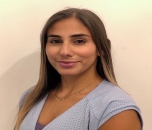Renowned Speakers

Leyla Ozbek
University College London Hospital, UK

Alzira Parolo
Brazil

TaÃsa Giannecchini
Fonoaudióloga ClÃnic Brazil

Voda Ioana
Clinica Nova – Explorari ORL, Romania

Mirabela Soare
Clinica Nova – Explorari ORL Romania

Ilaria Giudiceandrea
UK

Gabriela Barsova
Macedonia

Marija Jankulovska
Macedonia
Recommended Global Surgery Webinars & Conferences
Europe & UK
Asia Pacific & Middle East
ENT-2023
about conference
Conferences Series LLC Ltd invites all the participants from all over the world to attend “9th European Otolaryngology-ENT Surgery Conference” during December 04-05, 2023 in Rome, Italy , which includes keynote presentations, Oral talks and Poster presentations
ENT 2023 which aims to gather the most elegant societies and industries along with the renowned and honourable persons form top universities across the globe. ENT 2023 on behalf of its organizing Committee welcomes all the Otolaryngology researchers, industrialists, doctors, young scientists as well as student and corporate delegates to participate and to have a great experience. The theme of the conference is "Transdisciplinary Advance Research and Clinical Aspects in Ear, Nose & Throat Disorders". During ENT conferences, the International symposiums, B2B meetings, International workshops will also be organized to discuss the specific topics in the field of Rhinology and Otology. The conference also welcomes International exhibitions from corporate sectors to showcase the recent advancements in tools and techniques. Conferences Series organizes a 1000+ Global Events inclusive of 300+ Conferences, 500+ Upcoming and Previous Symposiums and Workshops in Asia, Europe, USA and Middle East with support from 1000 more scientific societies and publishes 700+ Open access journals which contains over 30000 eminent personalities, reputed scientists as editorial board members.
Young Researchers Forum - Young Scientist Awards
Young Research’s Awards at ENT 2023 for the Nomination: Young Researcher Forum - Outstanding Masters/Ph.D./Post Doctorate thesis work Presentation, only 25 presentations acceptable at the ENT 2023 young research forum.
Young Scientist Benefits
- Our conferences provide best Platform for your research through oral presentations.
- Share the ideas with both eminent researchers and mentors.
- Young Scientist Award reorganization certificate and memento to the winners
- Young Scientists will get appropriate and timely information by this Forum.
- Platform for collaboration among young researchers for better development
- Award should motivate participants to strive to realize their full potential which could in turn be beneficial to the field as whole.
Why to attend:
ENT 2023 is an international platform for presenting research about diagnosis, prevention and management and exchanging ideas about it and thus, contributes to the dissemination of knowledge in Rhinology and Otology for the benefit of both the academia and business.
The organizing committee of this ENT and Otolaryngology Conference is gearing up for an exciting and informative Webinar program including plenary lectures, symposia, workshops on a variety of topics, poster presentations and various programs for participants from all over the world. We invite you to join us at the ENT 2023, where you will be sure to have a meaningful experience with scholars from all around the world.
Target Audience:
- Scientists
- ENT Physicians
- ENT Surgeons
- Otologists
- Rhinologists
- Laryngologists
- Plastic Surgeons
- Young Researchers
- Students & Delegates
- Entrepreneurs
- Research Scholars
- Professional Service Professionals
- Otorhinolaryngology Societies
- Drug Manufacturing Companies
Scientific Sessions
Track 1: Otology/ Neurotology
Neurotology is a branch of otology concerned with those parts of the nervous system related to the ear, especially the inner ear and associated brainstem structures also called Otoneurology. Otology generally refers to the treatment of middle ear disease and resultant conductive hearing loss, whereas neurotology refers to treatment of inner ear conditions, or hearing and balance disorders. In this section we will discuss about Vestibular neuronitis, Facial nerve paralysis, Hearing loss and deafness, Labyrinthectomy, Vertigo, Perforated eardrum & Neuro Otolaryngology.
Related Topics: ENT 2023| Otolaryngology Conferences | Otology Conferences | ENT Conferences | Rhinology and Hypersensitivity Conferences | Audiology Conferences | Tinnitus Conferences | Physiological Disorders of Ear, Nose & Throat Conferences | Anesthesia in Ear, Nose and Throat Surgery Conferences | Sinusitis Conferences | Rhinology Conferences | Otolaryngology 2023 | Otorhinolaryngology Conferences | Otolaryngology congress | Otolaryngology Meetings | Otorhinolaryngology meetings
Related Societies: The South African Society of Otorhinolaryngology Head and Neck Surgery | The Australian Society of Otolaryngology Head and Neck Surgery | American Academy of Otolaryngology - Head and Neck Surgery | Canadian Society of Otolaryngology , American Laryngological Association | American Society of Pediatric Otolaryngology | North Carolina Society of Otolaryngology | International Corresponding Societies (ICS) | Indian Society Of Otology | Royal College of Surgeons | ENT Society | European Rhinologic Society | American Rhinologic Society
Track 2: New Trends in ENT
In the last 20 years, neonatal survival has progressively increased due to the constant amelioration of neonatal medical treatment and surgical techniques. These aspects have produced an increased incidence of children with congenital malformations and severe chronic pathologies. Moreover, the immigration of children from underdeveloped countries, where perinatal infections or other risk factors are still high, have further increased the number of paediatric patients who need rehabilitative care. It is worth noting that among over 50,000 scientific papers in the literature regarding paediatric rehabilitation, only about 1000 are related to ENT arguments. Thus, rehabilitation of paediatric patients with disorders of voice, speech and language, communication and hearing, deglutition and breathing is generally still inadequate to the real needs and rarely is well organised with multidisciplinary teams, working both in the hospital setting and in long-term care facilities. The aim of this track for study of presents some new trends in ENT.
Related Topics: ENT 2023 | Otolaryngology Conferences | Otology Conferences | ENT Conferences | Rhinology and Hypersensitivity Conferences | Audiology Conferences | Tinnitus Conferences | Physiological Disorders of Ear, Nose & Throat Conferences | Anesthesia in Ear, Nose and Throat Surgery Conferences | Sinusitis Conferences | Rhinology Conferences | Otolaryngology 2023 | Otorhinolaryngology Conferences | Otolaryngology congress | Otolaryngology Meetings | Otorhinolaryngology meetings
Related Societies: The South African Society of Otorhinolaryngology Head and Neck Surgery | The Australian Society of Otolaryngology Head and Neck Surgery | American Academy of Otolaryngology - Head and Neck Surgery | Canadian Society of Otolaryngology , American Laryngological Association | American Society of Pediatric Otolaryngology | North Carolina Society of Otolaryngology | International Corresponding Societies (ICS) | Indian Society Of Otology | Royal College of Surgeons | ENT Society | European Rhinologic Society | American Rhinologic Society
Track 3: Head and Neck Surgery and Oncology
Cancers of the mouth (lip and tongue), larynx (voice box), pharynx (throat), salivary glands, and nose/nasal passages are generally known as head and neck cancer and study of this is known as Oncology. These cancers typically form in the squamous cells, which are the cells lining the moistened, mucosal locations of the head and neck, such as the nose, mouth and throat. Such squamous cell cancers are usually termed, squamous cell carcinoma of the head and neck or head and neck squamous-cell carcinoma. Head and Neck Oncology encompasses all aspects of clinical practice, basic and translational research on the aetiology, pathophysiology, diagnosis, assessment, management, follow-up and prognosis of patients with head and neck tumors and carotid body tumor. The Head and Neck Surgery track will provides the details of advanced diagnostic testing and leading-edge medical and surgical treatment for the full scope of head and neck conditions. Head and neck cancer is strongly associated with certain environmental and lifestyle risk factors, including tobacco smoking, alcohol consumption, UV light, particular chemicals used in certain workplaces, and certain strains of viruses, such as human papillomavirus. These cancers are frequently aggressive in their biologic behavior; patients with these types of cancer are at a higher risk of developing another cancer in the head and neck area. Head and neck cancer is highly curable if detected early, usually through surgery, but radiation therapy may also play an important role, while chemotherapy is often ineffective. This track discusses about Squamous cell carcinoma, Oral Epidemiology, Head and Neck Surgery, Head and Neck Cancer viruses, Carotid body tumor and HNS Oncology.
Related Topics: ENT 2023 | Otolaryngology Conferences | Otology Conferences | ENT Conferences | Rhinology and Hypersensitivity Conferences | Audiology Conferences | Tinnitus Conferences | Physiological Disorders of Ear, Nose & Throat Conferences | Anesthesia in Ear, Nose and Throat Surgery Conferences | Sinusitis Conferences | Rhinology Conferences | Otolaryngology 2023 | Otorhinolaryngology Conferences | Otolaryngology congress | Otolaryngology Meetings | Otorhinolaryngology meetings
Related Societies: The South African Society of Otorhinolaryngology Head and Neck Surgery | The Australian Society of Otolaryngology Head and Neck Surgery | American Academy of Otolaryngology - Head and Neck Surgery | Canadian Society of Otolaryngology , American Laryngological Association | American Society of Pediatric Otolaryngology | North Carolina Society of Otolaryngology | International Corresponding Societies (ICS) | Indian Society Of Otology | Royal College of Surgeons | ENT Society | European Rhinologic Society | American Rhinologic Society
Track 4: Pediatric Otolaryngology
Pediatrics ENT deals with children having common illnesses such as tonsillitis, sinusitis and ear infections (otitis media) using the latest guidelines for medical treatment and the most advanced techniques for surgical treatment. Pediatric Otorhinolaryngology is to concentrate and disseminate information concerning prevention, cure and care of otorhinolaryngology disorders in infants and children due to developmental, degenerative, infectious, neoplastic, traumatic, social, psychiatric and economic causes.
Related Topics: ENT 2023 | Otolaryngology Conferences | Otology Conferences | ENT Conferences | Rhinology and Hypersensitivity Conferences | Audiology Conferences | Tinnitus Conferences | Physiological Disorders of Ear, Nose & Throat Conferences | Anesthesia in Ear, Nose and Throat Surgery Conferences | Sinusitis Conferences | Rhinology Conferences | Otolaryngology 2023| Otorhinolaryngology Conferences | Otolaryngology congress | Otolaryngology Meetings | Otorhinolaryngology meetings
Related Societies: The South African Society of Otorhinolaryngology Head and Neck Surgery | The Australian Society of Otolaryngology Head and Neck Surgery | American Academy of Otolaryngology - Head and Neck Surgery | Canadian Society of Otolaryngology , American Laryngological Association | American Society of Pediatric Otolaryngology | North Carolina Society of Otolaryngology | International Corresponding Societies (ICS) | Indian Society Of Otology | Royal College of Surgeons | ENT Society | European Rhinologic Society | American Rhinologic Society
Track 5: Hearing Impairment and Deafness Causes
Hearing loss can be caused by many different causes, some of which can be successfully treated with medicine or surgery, depending on the disease process. There are 3 types of Hearing Loss: Conductive hearing loss, Sensorineural hearing loss (SNHL), mixed hearing loss. This track will discuss the detail study of causes and treatment of deafness and hearing loss such as sudden deafness and permanent hear loss, Deaf-Blindness, Stapedectomy, Otological transplants and implants and Auditory Neuropathy Spectrum Disorder (ANSD). Surgical part of this track will focus on topics Tympanostomy and tympanoplasty, Assistive communication devices- Cochlear Implants, Tinnitus retraining therapy, Treatment of natural sinus ostium
Related Topics: ENT 2023 | Otolaryngology Conferences | Otology Conferences | ENT Conferences | Rhinology and Hypersensitivity Conferences | Audiology Conferences | Tinnitus Conferences | Physiological Disorders of Ear, Nose & Throat Conferences | Anesthesia in Ear, Nose and Throat Surgery Conferences | Sinusitis Conferences | Rhinology Conferences | Otolaryngology 2023 | Otorhinolaryngology Conferences | Otolaryngology congress | Otolaryngology Meetings | Otorhinolaryngology meetings
Related Societies: The South African Society of Otorhinolaryngology Head and Neck Surgery | The Australian Society of Otolaryngology Head and Neck Surgery | American Academy of Otolaryngology - Head and Neck Surgery | Canadian Society of Otolaryngology , American Laryngological Association | American Society of Pediatric Otolaryngology | North Carolina Society of Otolaryngology | International Corresponding Societies (ICS) | Indian Society Of Otology | Royal College of Surgeons | ENT Society | European Rhinologic Society | American Rhinologic Society
Track 6: Rhinology and Allergy
Rhinology defines as the study of nose, including the sinuses. Rhinology concerns itself with medical and surgical diseases of the nasal passages as well as paranasal sinuses. It is becoming more important after the introduction of nasal endoscopes. Allergies, also known as allergic diseases, are a number of conditions caused by hypersensitivity of the immune system to something in the environment that usually causes little or no problem in most people. These diseases include hay fever, food allergies, atopic dermatitis, allergic asthma, and anaphylaxis. Symptoms may include red eyes, an itchy rash, runny nose, shortness of breath, or swelling. Allergies are common. In the developed world, about 20% of people are affected by allergic rhinitis; about 6% of people have at least one food allergy.
Related Topics: ENT 2023 | Otolaryngology Conferences | Otology Conferences | ENT Conferences | Rhinology and Hypersensitivity Conferences | Audiology Conferences | Tinnitus Conferences | Physiological Disorders of Ear, Nose & Throat Conferences | Anesthesia in Ear, Nose and Throat Surgery Conferences | Sinusitis Conferences | Rhinology Conferences | Otolaryngology 2023 | Otorhinolaryngology Conferences | Otolaryngology congress | Otolaryngology Meetings | Otorhinolaryngology meetings
Related Societies: The South African Society of Otorhinolaryngology Head and Neck Surgery | The Australian Society of Otolaryngology Head and Neck Surgery | American Academy of Otolaryngology - Head and Neck Surgery | Canadian Society of Otolaryngology , American Laryngological Association | American Society of Pediatric Otolaryngology | North Carolina Society of Otolaryngology | International Corresponding Societies (ICS) | Indian Society Of Otology | Royal College of Surgeons | ENT Society | European Rhinologic Society | American Rhinologic Society
Track 7: Laryngology
It is a branch of medicine that deals with disorders, diseases and injuries of the vocal apparatus, especially the larynx. Common conditions addressed by laryngologists include vocal fold nodules and cysts, laryngeal cancer, spasmodic dysphonia, laryngopharyngeal reflux, papilloma, and voice misuse/abuse/overuse syndromes.
Related Topics: ENT 2023 | Otolaryngology Conferences | Otology Conferences | ENT Conferences | Rhinology and Hypersensitivity Conferences | Audiology Conferences | Tinnitus Conferences | Physiological Disorders of Ear, Nose & Throat Conferences | Anesthesia in Ear, Nose and Throat Surgery Conferences | Sinusitis Conferences | Rhinology Conferences | Otolaryngology 2023 | Otorhinolaryngology Conferences | Otolaryngology congress | Otolaryngology Meetings | Otorhinolaryngology meetings
Related Societies: The South African Society of Otorhinolaryngology Head and Neck Surgery | The Australian Society of Otolaryngology Head and Neck Surgery | American Academy of Otolaryngology - Head and Neck Surgery | Canadian Society of Otolaryngology , American Laryngological Association | American Society of Pediatric Otolaryngology | North Carolina Society of Otolaryngology | International Corresponding Societies (ICS) | Indian Society Of Otology | Royal College of Surgeons | ENT Society | European Rhinologic Society | American Rhinologic Society
Track 8: Otolaryngology
Otolaryngology is a surgical subspecialty in medical terms that deals with Conditions of the ear, nose, and throat (ENT) and related structures of the head and neck. Specialists who represent considerable authority around there are called Otorhinolaryngologist, otolaryngologists, ENT specialists or head and neck specialists. Patients look for treatment from an otorhinolaryngologist for infections of the ear, nose, throat, base of the skull, and for the surgical administration of diseases and benevolent tumors of the head and neck. physicians trained in the medical and surgical management and treatment of patients with diseases and disorders of the ear, nose, throat (ENT), and related structures of the head and neck. They are commonly referred to as ENT physicians.
Related Topics: ENT 2023 | Otolaryngology Conferences | Otology Conferences | ENT Conferences | Rhinology and Hypersensitivity Conferences | Audiology Conferences | Tinnitus Conferences | Physiological Disorders of Ear, Nose & Throat Conferences | Anesthesia in Ear, Nose and Throat Surgery Conferences | Sinusitis Conferences | Rhinology Conferences | Otolaryngology 2023 | Otorhinolaryngology Conferences | Otolaryngology congress | Otolaryngology Meetings | Otorhinolaryngology meetings
Related Societies: The South African Society of Otorhinolaryngology Head and Neck Surgery | The Australian Society of Otolaryngology Head and Neck Surgery | American Academy of Otolaryngology - Head and Neck Surgery | Canadian Society of Otolaryngology , American Laryngological Association | American Society of Pediatric Otolaryngology | North Carolina Society of Otolaryngology | International Corresponding Societies (ICS) | Indian Society Of Otology | Royal College of Surgeons | ENT Society | European Rhinologic Society | American Rhinologic Society
Track 9: Surgical Approaches for Ear, Nose and Throat diseases
Hearing loss can be caused by many different causes, some of which can be successfully treated with medicine or surgery, depending on the disease process. There are 3 types of Hearing Loss: Conductive hearing loss, Sensorineural hearing loss (SNHL), mixed hearing loss. This track will discuss the detail study of causes and treatment of deafness and hearing loss such as Sudden deafness and permanent hearloss, Deaf-Blindness, Stapedectomy, Otological transplants and implants and Auditory Neuropathy Spectrum Disorder (ANSD). Surgical part of this track will focus on topics Tympanostomy and tympanoplasty, Assistive communication devices- Cochlear Implants, Tinnitus retraining therapy, Treatment of natural sinus ostium. With recent advances in technology, including the nasal endoscope, nose or sinus surgery is now commonly performed entirely through the nose, without face or mouth incisions. Today, endoscopic sinus surgery is typically done with minimal nasal packing, mild pain, and short recovery times.
Related Topics: ENT 2023 | Otolaryngology Conferences | Otology Conferences | ENT Conferences | Rhinology and Hypersensitivity Conferences | Audiology Conferences | Tinnitus Conferences | Physiological Disorders of Ear, Nose & Throat Conferences | Anesthesia in Ear, Nose and Throat Surgery Conferences | Sinusitis Conferences | Rhinology Conferences | Otolaryngology 2023 | Otorhinolaryngology Conferences | Otolaryngology congress | Otolaryngology Meetings | Otorhinolaryngology meetings
Related Societies: The South African Society of Otorhinolaryngology Head and Neck Surgery | The Australian Society of Otolaryngology Head and Neck Surgery | American Academy of Otolaryngology - Head and Neck Surgery | Canadian Society of Otolaryngology , American Laryngological Association | American Society of Pediatric Otolaryngology | North Carolina Society of Otolaryngology | International Corresponding Societies (ICS) | Indian Society Of Otology | Royal College of Surgeons | ENT Society | European Rhinologic Society | American Rhinologic Society
Track 10: Intraoperative neurophysiological monitoring
Intraoperative neurophysiological Monitoring (IONM) or intraoperative neuromonitoring is the utilization of electrophysiological techniques, for example, electroencephalography (EEG), electromyography (EMG), and evoked possibilities to screen the useful respectability of certain neural structures (e.g., nerves, spinal string and parts of the cerebrum) amid surgery. The reason for IONM is to lessen the hazard to the patient of iatrogenic harm to the sensory system, as well as to provide functional guidance to the surgeon and anesthesiologist.
Related Topics: ENT 2023 | Otolaryngology Conferences | Otology Conferences | ENT Conferences | Rhinology and Hypersensitivity Conferences | Audiology Conferences | Tinnitus Conferences | Physiological Disorders of Ear, Nose & Throat Conferences | Anesthesia in Ear, Nose and Throat Surgery Conferences | Sinusitis Conferences | Rhinology Conferences | Otolaryngology 2023| Otorhinolaryngology Conferences | Otolaryngology congress | Otolaryngology Meetings | Otorhinolaryngology meetings
Related Societies: The South African Society of Otorhinolaryngology Head and Neck Surgery | The Australian Society of Otolaryngology Head and Neck Surgery | American Academy of Otolaryngology - Head and Neck Surgery | Canadian Society of Otolaryngology , American Laryngological Association | American Society of Pediatric Otolaryngology | North Carolina Society of Otolaryngology | International Corresponding Societies (ICS) | Indian Society Of Otology | Royal College of Surgeons | ENT Society | European Rhinologic Society | American Rhinologic Society
Track 11: Anesthesia in Ear, Nose and Throat Surgery
Acute pain may occur due to trauma, surgery, infection, disruption of blood circulation, or many other conditions in which tissue injury occurs. In a medical setting, pain alleviation is desired when its warning function is no longer needed. Besides improving patient comfort, pain therapy can also reduce harmful physiological consequences of untreated pain. Children account for approximately one-third of all patients undergoing ear, nose and throat (ENT) surgery. Procedures range from simple day-case operations, such as myringotomy, to complex airway reconstruction surgery undertaken in specialist centres. This track describes the anaesthetic management of some of the commonly performed paediatric ENT procedures, including adenotonsillectomy, oesophagoscopy, and middle ear surgery. ENT operations, head and neck surgery (infiltration anesthesia, field blocks, or peripheral nerve blocks, plexus anesthesia)
Related Topics: ENT 2023 | Otolaryngology Conferences | Otology Conferences | ENT Conferences | Rhinology and Hypersensitivity Conferences | Audiology Conferences | Tinnitus Conferences | Physiological Disorders of Ear, Nose & Throat Conferences | Anesthesia in Ear, Nose and Throat Surgery Conferences | Sinusitis Conferences | Rhinology Conferences | Otolaryngology 2023 | Otorhinolaryngology Conferences | Otolaryngology congress | Otolaryngology Meetings | Otorhinolaryngology meetings
Related Societies: The South African Society of Otorhinolaryngology Head and Neck Surgery | The Australian Society of Otolaryngology Head and Neck Surgery | American Academy of Otolaryngology - Head and Neck Surgery | Canadian Society of Otolaryngology , American Laryngological Association | American Society of Pediatric Otolaryngology | North Carolina Society of Otolaryngology | International Corresponding Societies (ICS) | Indian Society Of Otology | Royal College of Surgeons | ENT Society | European Rhinologic Society | American Rhinologic Society
Track 12: Speech Language Pathology
Speech-language pathologists (SLPs) provide a wide range of services, mainly on an individual basis, but also as support for individuals, families, support groups, and providing information for the general public. Speech-language pathologists work to prevent, assess, diagnose, and treat speech, language, social communication, cognitive-communication, and swallowing disorders in children and adults.
Related Topics: ENT 2023 | Otolaryngology Conferences | Otology Conferences | ENT Conferences | Rhinology and Hypersensitivity Conferences | Audiology Conferences | Tinnitus Conferences | Physiological Disorders of Ear, Nose & Throat Conferences | Anesthesia in Ear, Nose and Throat Surgery Conferences | Sinusitis Conferences | Rhinology Conferences | Otolaryngology 2023 | Otorhinolaryngology Conferences | Otolaryngology congress | Otolaryngology Meetings | Otorhinolaryngology meetings
Related Societies: The South African Society of Otorhinolaryngology Head and Neck Surgery | The Australian Society of Otolaryngology Head and Neck Surgery | American Academy of Otolaryngology - Head and Neck Surgery | Canadian Society of Otolaryngology , American Laryngological Association | American Society of Pediatric Otolaryngology | North Carolina Society of Otolaryngology | International Corresponding Societies (ICS) | Indian Society Of Otology | Royal College of Surgeons | ENT Society | European Rhinologic Society | American Rhinologic Society
Track 13: Surgery for Nasal Disorders
With recent advances in technology, including the nasal endoscope, nose or sinus surgery is now commonly performed entirely through the nose, without face or mouth incisions. Today, endoscopic sinus surgery is typically done with minimal nasal packing, mild pain, and short recovery times. Surgical Approaches for Nasal Disorders track discusses topics like Surgical navigation and Intraoperative Imaging, Endoscopic applications in orbital Surgery, Somnoplasty, septoplasty, Ossicular chain reconstruction and Management of superior canal dehiscence.
Related Topics: ENT 2023 | Otolaryngology Conferences | Otology Conferences | ENT Conferences | Rhinology and Hypersensitivity Conferences | Audiology Conferences | Tinnitus Conferences | Physiological Disorders of Ear, Nose & Throat Conferences | Anesthesia in Ear, Nose and Throat Surgery Conferences | Sinusitis Conferences | Rhinology Conferences | Otolaryngology 2023 | Otorhinolaryngology Conferences | Otolaryngology congress | Otolaryngology Meetings | Otorhinolaryngology meetings
Related Societies: The South African Society of Otorhinolaryngology Head and Neck Surgery | The Australian Society of Otolaryngology Head and Neck Surgery | American Academy of Otolaryngology - Head and Neck Surgery | Canadian Society of Otolaryngology , American Laryngological Association | American Society of Pediatric Otolaryngology | North Carolina Society of Otolaryngology | International Corresponding Societies (ICS) | Indian Society Of Otology | Royal College of Surgeons | ENT Society | European Rhinologic Society | American Rhinologic Society
Track 14: Facial Plastic and Reconstructive Surgery
The Facial Plastic and Reconstructive Surgery track concentrate on the treatment of patients who have procured, innate and present malignancy abnormalities on the face and neck. Systems extend from negligibly obtrusive strategies to cutting edge operations, The Facial Plastic and Reconstructive Surgery track focus on the treatment of patients who have acquired, congenital and post-cancer irregularities to the face and neck. The goal is to restore natural form and function and enable patients to live as close to normal lives as possible. Techniques range from minimally invasive procedures to advanced operations, using tissue modifications, microvascular free tissue transfer, bone replacement and dynamic facial flaps. Our surgeons can restore movement to paralyzed faces, return skin color and contour to patients with deformities and optimize critical functions such as speech, swallowing and breathing. Some of the topics to be discussed are: Rhinoplasty, Septoplasty, Otoplasty, Complex lacerations and soft tissue damage, Basal Cell Carcinoma and Rhinology Surgery.
Related Topics: ENT 2023| Otolaryngology Conferences | Otology Conferences | ENT Conferences | Rhinology and Hypersensitivity Conferences | Audiology Conferences | Tinnitus Conferences | Physiological Disorders of Ear, Nose & Throat Conferences | Anesthesia in Ear, Nose and Throat Surgery Conferences | Sinusitis Conferences | Rhinology Conferences | Otolaryngology 2023 | Otorhinolaryngology Conferences | Otolaryngology congress | Otolaryngology Meetings | Otorhinolaryngology meetings
Related Societies: The South African Society of Otorhinolaryngology Head and Neck Surgery | The Australian Society of Otolaryngology Head and Neck Surgery | American Academy of Otolaryngology - Head and Neck Surgery | Canadian Society of Otolaryngology , American Laryngological Association | American Society of Pediatric Otolaryngology | North Carolina Society of Otolaryngology | International Corresponding Societies (ICS) | Indian Society Of Otology | Royal College of Surgeons | ENT Society | European Rhinologic Society | American Rhinologic Society
Track 15: Obstructive Sleep Apnea (OSA)
Most common type of sleep apnea and is caused by complete or partial obstructions of the upper airway. It is characterized by repetitive episodes of shallow or paused breathing during sleep, despite the effort to breathe, and is usually associated with a reduction in blood oxygen saturation. Sleep apnea is a sleep disorder characterized by pauses in breathing or periods of shallow breathing during sleep. In the most common form this follows loud snoring. There may be a choking or snorting sound as breathing resumes. As it disrupts normal sleep, those affected are often sleepy or tired during the day. In children it may cause problems in school or hyperactivity. There are three forms of sleep apnea, obstructive (OSA), central (CSA), and a combination of the two. OSA is the most common form. Risk factors for OSA include being overweight, a family history of the condition, allergies, and enlarged tonsils. In OSA, breathing is interrupted by a blockage of airflow, while in CSA breathing stops due to a lack of effort to breathe. People with sleep apnea are often not aware they have it. Often it is picked up by a family member. Sleep apnea is often diagnosed with an overnight sleep study.
Related Topics: ENT 2023 | Otolaryngology Conferences | Otology Conferences | ENT Conferences | Rhinology and Hypersensitivity Conferences | Audiology Conferences | Tinnitus Conferences | Physiological Disorders of Ear, Nose & Throat Conferences | Anesthesia in Ear, Nose and Throat Surgery Conferences | Sinusitis Conferences | Rhinology Conferences | Otolaryngology 2023 | Otorhinolaryngology Conferences | Otolaryngology congress | Otolaryngology Meetings | Otorhinolaryngology meetings
Related Societies: The South African Society of Otorhinolaryngology Head and Neck Surgery | The Australian Society of Otolaryngology Head and Neck Surgery | American Academy of Otolaryngology - Head and Neck Surgery | Canadian Society of Otolaryngology , American Laryngological Association | American Society of Pediatric Otolaryngology | North Carolina Society of Otolaryngology | International Corresponding Societies (ICS) | Indian Society Of Otology | Royal College of Surgeons | ENT Society | European Rhinologic Society | American Rhinologic Society
Track 16: Current diagnosis and treatment in otolaryngology
Current Diagnosis & Treatment Otolaryngology spans the entire breadth of ENT topics, including the latest developments in basic science, facial plastic surgery, head and neck surgery, laryngology, rhinology, pediatric otolaryngology, otology, and neurotology. This find-it-now clinician's guide includes commonly encountered as well as unusual diseases of the head and neck and is essential for board review and recertification.
Related Topics: ENT 2023 | Otolaryngology Conferences | Otology Conferences | ENT Conferences | Rhinology and Hypersensitivity Conferences | Audiology Conferences | Tinnitus Conferences | Physiological Disorders of Ear, Nose & Throat Conferences | Anesthesia in Ear, Nose and Throat Surgery Conferences | Sinusitis Conferences | Rhinology Conferences | Otolaryngology 2023 | Otorhinolaryngology Conferences | Otolaryngology congress | Otolaryngology Meetings | Otorhinolaryngology meetings
Related Societies: The South African Society of Otorhinolaryngology Head and Neck Surgery | The Australian Society of Otolaryngology Head and Neck Surgery | American Academy of Otolaryngology - Head and Neck Surgery | Canadian Society of Otolaryngology , American Laryngological Association | American Society of Pediatric Otolaryngology | North Carolina Society of Otolaryngology | International Corresponding Societies (ICS) | Indian Society Of Otology | Royal College of Surgeons | ENT Society | European Rhinologic Society | American Rhinologic Society
Track 17: Pathophysiology of Ear, Nose and Throat
Physiological Disorders of Ear, Nose & Throat causes certain disorders like Chronic nasal obstruction, Nasal polyposis, epistaxis and myasis, Rhinorrhoea & Rhinolith, Septal hematoma, Deviated nasal septum, Nasal reflexes, Post-Nasal drip & Young’s syndrome, cleft palate, Kartagener’s syndrome etc. Sinonasal disorders like Unified Airway disease, Asthma, tumors can be treated surgically through functional endoscopic sinus surgery, endoscopic frontal sinusotomy, transnasal endoscopic surgery, sinus dilation and stenting etc. Sinonasal anatomy, physiology and development and thyroid disorder is most common now a days.
Related Topics: ENT 2023 | Otolaryngology Conferences | Otology Conferences | ENT Conferences | Rhinology and Hypersensitivity Conferences | Audiology Conferences | Tinnitus Conferences | Physiological Disorders of Ear, Nose & Throat Conferences | Anesthesia in Ear, Nose and Throat Surgery Conferences | Sinusitis Conferences | Rhinology Conferences | Otolaryngology 2023 | Otorhinolaryngology Conferences | Otolaryngology congress | Otolaryngology Meetings | Otorhinolaryngology meetings
Related Societies: The South African Society of Otorhinolaryngology Head and Neck Surgery | The Australian Society of Otolaryngology Head and Neck Surgery | American Academy of Otolaryngology - Head and Neck Surgery | Canadian Society of Otolaryngology , American Laryngological Association | American Society of Pediatric Otolaryngology | North Carolina Society of Otolaryngology | International Corresponding Societies (ICS) | Indian Society Of Otology | Royal College of Surgeons | ENT Society | European Rhinologic Society | American Rhinologic Society
Track 18: Anatomy and Physiology of Ear, Nose, and Throat
Anatomical and Physiological Disorders of Ear, Nose & Throat causes certain disorders like Chronic nasal obstruction, Nasal polyposis, epistaxis and myasis, Rhinorrhoea & Rhinolith, Septal hematoma, Deviated nasal septum, Nasal reflexes, Post-Nasal drip & Young’s syndrome, cleft palate, Kartagener’s syndrome etc. Sinonasal disorders like Unified Airway disease, Asthma, tumors can be treated surgically through functional endoscopic sinus surgery, endoscopic frontal sinusotomy, transnasal endoscopic surgery, sinus dilation and stenting etc. Sinonasal anatomy, physiology and development and thyroid disorder is most common now a days.
Related Topics: ENT 2023 | Otolaryngology Conferences | Otology Conferences | ENT Conferences | Rhinology and Hypersensitivity Conferences | Audiology Conferences | Tinnitus Conferences | Physiological Disorders of Ear, Nose & Throat Conferences | Anesthesia in Ear, Nose and Throat Surgery Conferences | Sinusitis Conferences | Rhinology Conferences | Otolaryngology 2023 | Otorhinolaryngology Conferences | Otolaryngology congress | Otolaryngology Meetings | Otorhinolaryngology meetings
Related Societies: The South African Society of Otorhinolaryngology Head and Neck Surgery | The Australian Society of Otolaryngology Head and Neck Surgery | American Academy of Otolaryngology - Head and Neck Surgery | Canadian Society of Otolaryngology , American Laryngological Association | American Society of Pediatric Otolaryngology | North Carolina Society of Otolaryngology | International Corresponding Societies (ICS) | Indian Society Of Otology | Royal College of Surgeons | ENT Society | European Rhinologic Society | American Rhinologic Society
Track 19: ENT Infectious Diseases
A general ENT physicians treat infections involving the ears, nose, throat, sinuses, and skin of the head and neck; congenital, inflammatory, and other problems, such as dizziness, hearing loss, changes in taste or smell, or swallowing and voice problems; sinus disease; trauma and injuries to head and neck structures; and breathing problems of the nose, larynx (voicebox), or trachea (windpipe); and snoring and sleep disorders.
Related Topics: ENT 2023 | Otolaryngology Conferences | Otology Conferences | ENT Conferences | Rhinology and Hypersensitivity Conferences | Audiology Conferences | Tinnitus Conferences | Physiological Disorders of Ear, Nose & Throat Conferences | Anesthesia in Ear, Nose and Throat Surgery Conferences | Sinusitis Conferences | Rhinology Conferences | Otolaryngology 2023 | Otorhinolaryngology Conferences | Otolaryngology congress | Otolaryngology Meetings | Otorhinolaryngology meetings
Related Societies: The South African Society of Otorhinolaryngology Head and Neck Surgery | The Australian Society of Otolaryngology Head and Neck Surgery | American Academy of Otolaryngology - Head and Neck Surgery | Canadian Society of Otolaryngology , American Laryngological Association | American Society of Pediatric Otolaryngology | North Carolina Society of Otolaryngology | International Corresponding Societies (ICS) | Indian Society Of Otology | Royal College of Surgeons | ENT Society | European Rhinologic Society | American Rhinologic Society
Track 20: Sinusitis-Types and Treatment
Sinusitis is an inflammation, or swelling, of the tissue lining the sinuses. Normally, sinus is filled with air, but when sinuses become blocked and filled with fluid, germs can grow and cause an infection. Conditions that can cause sinus blockage include the common cold, allergic rhinitis, nasal polyps, or a deviated septum. In children, common environmental factors that contribute to sinusitis include allergies, illness from other children at day care or school, pacifiers, bottle drinking while lying on one's back, and smoke in the environment. In this tracks we will come across topics such as Acute sinusitis, Antimicrobial resistance profiles of ocular and nasal flora, Sinus headaches- Causes and treatment & Pediatric sinusitis
Related Topics: ENT 2023 | Otolaryngology Conferences | Otology Conferences | ENT Conferences | Rhinology and Hypersensitivity Conferences | Audiology Conferences | Tinnitus Conferences | Physiological Disorders of Ear, Nose & Throat Conferences | Anesthesia in Ear, Nose and Throat Surgery Conferences | Sinusitis Conferences | Rhinology Conferences | Otolaryngology 2023 | Otorhinolaryngology Conferences | Otolaryngology congress | Otolaryngology Meetings | Otorhinolaryngology meetings
Related Societies: The South African Society of Otorhinolaryngology Head and Neck Surgery | The Australian Society of Otolaryngology Head and Neck Surgery | American Academy of Otolaryngology - Head and Neck Surgery | Canadian Society of Otolaryngology , American Laryngological Association | American Society of Pediatric Otolaryngology | North Carolina Society of Otolaryngology | International Corresponding Societies (ICS) | Indian Society Of Otology | Royal College of Surgeons | ENT Society | European Rhinologic Society | American Rhinologic Society
Track 21: Rhinitis and Rhinosinusitis - Types and Treatment
Rhinitis is a condition occurs due to inflammation and irritation of Mucous membrane. The inflammation is caused by the degranulation of mast cells in the nose. Irritation of mucous membrane is caused due to allergens like pollen and dander. Rhinitis can be classified as Allergic Rhinitis and non-Allergic Rhinitis basing on the causative agent. Allergic rhinitis is more common in some countries than others; in the United States, about 10%–30% of adults are affected annually. Fungal and Bacterial Rhinosinusitis is caused due to microorganisms affecting the nasal membranes. Infectious Rhinitis or Rhinosinusitis can be treated by vaccinations while allergic rhinitis can be treated by intranasal corticosteroids and antihistamines.
Related Topics: ENT 2023 | Otolaryngology Conferences | Otology Conferences | ENT Conferences | Rhinology and Hypersensitivity Conferences | Audiology Conferences | Tinnitus Conferences | Physiological Disorders of Ear, Nose & Throat Conferences | Anesthesia in Ear, Nose and Throat Surgery Conferences | Sinusitis Conferences | Rhinology Conferences | Otolaryngology 2023 | Otorhinolaryngology Conferences | Otolaryngology congress | Otolaryngology Meetings | Otorhinolaryngology meetings
Related Societies: The South African Society of Otorhinolaryngology Head and Neck Surgery | The Australian Society of Otolaryngology Head and Neck Surgery | American Academy of Otolaryngology - Head and Neck Surgery | Canadian Society of Otolaryngology , American Laryngological Association | American Society of Pediatric Otolaryngology | North Carolina Society of Otolaryngology | International Corresponding Societies (ICS) | Indian Society Of Otology | Royal College of Surgeons | ENT Society | European Rhinologic Society | American Rhinologic Society
Track 22: ENT Technology
ENT Navigation System is an innovative electromagnetic image-guided surgery system. It allows you to operate with the maximum amount of information about the unique anatomy of each patient and “see” the relative location of the instrument tip in the patient’s sinus anatomy. Image-guided surgery with the Fusion system can help make more informed decisions in the operating room for safer, more thorough procedures. The Fusion system provides:
Reliable accuracy: the first and only electromagnetic ENT system with reproducible accuracy comparable to our optical navigation systems.
Ease of use: the first and only electromagnetic system that includes automated instrument verification, reusable instruments, multiple registration modalities, multi-instrument tracking, and customizable surgeon and procedure specific settings.
Expandability: customize your image-guided surgery system with additional procedure modules and associated instruments.
Reusable standard instruments: includes a set of 6 standard ENT instruments and custom tray.
Related Topics: ENT 2023 | Otolaryngology Conferences | Otology Conferences | ENT Conferences | Rhinology and Hypersensitivity Conferences | Audiology Conferences | Tinnitus Conferences | Physiological Disorders of Ear, Nose & Throat Conferences | Anesthesia in Ear, Nose and Throat Surgery Conferences | Sinusitis Conferences | Rhinology Conferences | Otolaryngology 2023 | Otorhinolaryngology Conferences | Otolaryngology congress | Otolaryngology Meetings | Otorhinolaryngology meetings
Related Societies: The South African Society of Otorhinolaryngology Head and Neck Surgery | The Australian Society of Otolaryngology Head and Neck Surgery | American Academy of Otolaryngology - Head and Neck Surgery | Canadian Society of Otolaryngology , American Laryngological Association | American Society of Pediatric Otolaryngology | North Carolina Society of Otolaryngology | International Corresponding Societies (ICS) | Indian Society Of Otology | Royal College of Surgeons | ENT Society | European Rhinologic Society | American Rhinologic Society
Track 23: Sinonasal Disorders and Surgical Treatment
The nasal passage and paranasal sinuses (collectively sinonasal) plays host to a number of diseases and conditions. This can be collectively termed sinonasal disease or disorder. Sinusitis affecting children is termed as Pediatric sinusitis. This session discusses Acute and Chronic sinusitis along with clinical features, pathophysiology, diagnosis and management. Sinusitis causes Sinus Headaches and Sinus Infections, the causes and treatment aspects are the major points for discussion. Pediatric Sinusitis can be treated by Sinus surgery. Nasal Irrigation, Antibiotic Therapy and Topical drug delivery are the treatment measures available for Sinusitis. The imaging characteristics of Sinonasal inflammatory conditions are varied. The role of imaging is to identify patterns of disease, provide a roadmap for the endoscopist, identify anatomical variants that impact on drainage, and exclude aggressive pathology. In this track we discuss issue such as Congenital sinonasal disorders, Sinonasal manifestations of systemic disease, Functional endoscopic sinus surgery, Transnasal endoscopic surgery and sinus drainage
Related Topics: ENT 2023 | Otolaryngology Conferences | Otology Conferences | ENT Conferences | Rhinology and Hypersensitivity Conferences | Audiology Conferences | Tinnitus Conferences | Physiological Disorders of Ear, Nose & Throat Conferences | Anesthesia in Ear, Nose and Throat Surgery Conferences | Sinusitis Conferences | Rhinology Conferences | Otolaryngology 2023 | Otorhinolaryngology Conferences | Otolaryngology congress | Otolaryngology Meetings | Otorhinolaryngology meetings
Related Societies: The South African Society of Otorhinolaryngology Head and Neck Surgery | The Australian Society of Otolaryngology Head and Neck Surgery | American Academy of Otolaryngology - Head and Neck Surgery | Canadian Society of Otolaryngology , American Laryngological Association | American Society of Pediatric Otolaryngology | North Carolina Society of Otolaryngology | International Corresponding Societies (ICS) | Indian Society Of Otology | Royal College of Surgeons | ENT Society | European Rhinologic Society | American Rhinologic Society
Track 24: Ear Disorders
An ear disease is most often a bacterial or viral infection that affects the middle ear, the air-filled space behind the eardrum that contains the tiny vibrating bones of the ear. Children are more likely than adults to get ear infections. Ear infections frequently are painful because of inflammation and buildup of fluids in the middle ear. Because ear infections often clear up on their own, treatment may begin with managing pain and monitoring the problem. Ear infection in infants and severe cases in general often require antibiotic medications. Long-term problems related to ear infections — persistent fluids in the middle ear, persistent infections or frequent infections — can cause hearing problems and other serious complications. In this tracks we go through some of the issue related to ear disorder and treatment such as acute external otits, Prechondritis pinna- Cauliflower ear, Congenital malformations- Microtia, Atresia, Otomycosis and Cochlear Implants
Related Topics: ENT 2023 | Otolaryngology Conferences | Otology Conferences | ENT Conferences | Rhinology and Hypersensitivity Conferences | Audiology Conferences | Tinnitus Conferences | Physiological Disorders of Ear, Nose & Throat Conferences | Anesthesia in Ear, Nose and Throat Surgery Conferences | Sinusitis Conferences | Rhinology Conferences | Otolaryngology 2023 | Otorhinolaryngology Conferences | Otolaryngology congress | Otolaryngology Meetings | Otorhinolaryngology meetings
Related Societies: The South African Society of Otorhinolaryngology Head and Neck Surgery | The Australian Society of Otolaryngology Head and Neck Surgery | American Academy of Otolaryngology - Head and Neck Surgery | Canadian Society of Otolaryngology , American Laryngological Association | American Society of Pediatric Otolaryngology | North Carolina Society of Otolaryngology | International Corresponding Societies (ICS) | Indian Society Of Otology | Royal College of Surgeons | ENT Society | European Rhinologic Society | American Rhinologic Society
Track 25: Tinnitus
Tinnitus the perception of sound in the absence of actual external sound-represents a symptom of an underlying condition rather than a single disease. Several theories have been proposed to explain the mechanisms underlying tinnitus. Tinnitus, the noise can be intermittent or continuous, and is very loud. Tinnitus is often associated with hearing loss, it does not cause the loss, nor does a hearing loss cause tinnitus. People with tinnitus experience no difficulty hearing, and in a few cases they even become so sensitive to sound that they must take steps to muffle or mask external noises. Prolonged exposure to loud sounds is the most common cause of tinnitus. Up to 90% of people with tinnitus have some level of noise-induced hearing loss. The noise causes permanent damage to the sound-sensitive cells of the cochlea, a spiral-shaped organ in the inner ear. A single exposure to a sudden extremely loud noise can also cause tinnitus. This track deals some of the most important topic which includes: Chronic sensorineural tinnitus, Tinnitus from sound exposure, Pharmacological treatment and Behavioral treatment, Electrical stimulation and vascular compression of the auditory nerve.
Related Topics: ENT 2023 | Otolaryngology Conferences | Otology Conferences | ENT Conferences | Rhinology and Hypersensitivity Conferences | Audiology Conferences | Tinnitus Conferences | Physiological Disorders of Ear, Nose & Throat Conferences | Anesthesia in Ear, Nose and Throat Surgery Conferences | Sinusitis Conferences | Rhinology Conferences | Otolaryngology 2023 | Otorhinolaryngology Conferences | Otolaryngology congress | Otolaryngology Meetings | Otorhinolaryngology meetings
Related Societies: The South African Society of Otorhinolaryngology Head and Neck Surgery | The Australian Society of Otolaryngology Head and Neck Surgery | American Academy of Otolaryngology - Head and Neck Surgery | Canadian Society of Otolaryngology , American Laryngological Association | American Society of Pediatric Otolaryngology | North Carolina Society of Otolaryngology | International Corresponding Societies (ICS) | Indian Society Of Otology | Royal College of Surgeons | ENT Society | European Rhinologic Society | American Rhinologic Society
Track 26: New Treatment Approaches for Hearing & Speech Disorders
Hearing loss is the most common form of sensory impairment in humans and affects more than 40 million people worldwide. Over recent years, more than 100 genetic loci have been linked to hearing loss and many of the affected genes have been identified. This understanding of the genetic pathways that regulate auditory function has revealed new targets for pharmacological treatment of the disease. Moreover, approaches that are based on stem cells and gene therapy, which may have the potential to restore or maintain auditory function, are beginning to emerge.
Related Topics: ENT 2023 | Otolaryngology Conferences | Otology Conferences | ENT Conferences | Rhinology and Hypersensitivity Conferences | Audiology Conferences | Tinnitus Conferences | Physiological Disorders of Ear, Nose & Throat Conferences | Anesthesia in Ear, Nose and Throat Surgery Conferences | Sinusitis Conferences | Rhinology Conferences | Otolaryngology 2023 | Otorhinolaryngology Conferences | Otolaryngology congress | Otolaryngology Meetings | Otorhinolaryngology meetings
Related Societies: The South African Society of Otorhinolaryngology Head and Neck Surgery | The Australian Society of Otolaryngology Head and Neck Surgery | American Academy of Otolaryngology - Head and Neck Surgery | Canadian Society of Otolaryngology , American Laryngological Association | American Society of Pediatric Otolaryngology | North Carolina Society of Otolaryngology | International Corresponding Societies (ICS) | Indian Society Of Otology | Royal College of Surgeons | ENT Society | European Rhinologic Society | American Rhinologic Society
Track 27: Surgical Approaches for Larynx in Adults and Pediatrics
Laryngology is that branch of medicine which deals with disorders, diseases and injuries of the vocal apparatus, especially the larynx. The track of Laryngology will deal with disorders, diseases and injuries of the vocal apparatus, especially the larynx. Common conditions addressed by laryngologists include vocal fold nodules and cysts, laryngeal cancer, spasmodic dysphonia, laryngopharyngeal reflux, papillomas and voice misuse/abuse/overuse syndromes. Some of the most common disease is due to excessive talking, throat clearing, coughing, smoking, screaming, singing, or speaking too loudly or too low. The other division of the tracks deal with the surgical approaches in case of adults and pediatrics. Some of the topics will be focused such as: Head and Neck Surgery, Dysphagia, Total laryngectomy, Surgery for swallowing disorders, Translaser microsurgery for larynx & Tonsillectomy in children.
Related Topics: ENT 2023 | Otolaryngology Conferences | Otology Conferences | ENT Conferences | Rhinology and Hypersensitivity Conferences | Audiology Conferences | Tinnitus Conferences | Physiological Disorders of Ear, Nose & Throat Conferences | Anesthesia in Ear, Nose and Throat Surgery Conferences | Sinusitis Conferences | Rhinology Conferences | Otolaryngology 2023 | Otorhinolaryngology Conferences | Otolaryngology congress | Otolaryngology Meetings | Otorhinolaryngology meetings
Related Societies: The South African Society of Otorhinolaryngology Head and Neck Surgery | The Australian Society of Otolaryngology Head and Neck Surgery | American Academy of Otolaryngology - Head and Neck Surgery | Canadian Society of Otolaryngology , American Laryngological Association | American Society of Pediatric Otolaryngology | North Carolina Society of Otolaryngology | International Corresponding Societies (ICS) | Indian Society Of Otology | Royal College of Surgeons | ENT Society | European Rhinologic Society | American Rhinologic Society
Market Analysis
With increase in predominance of ear, nose and throat disorders in geriatric people the demand of ENT devices expected to drive the ENT devices industry rapidly over the upcoming years. Expanding heights of healthcare awareness among patients and healthcare professionals expected to increase the growth of the market over the forecast period.
Presence of sophisticated healthcare infrastructure in the communities, favorable government initiatives led to progress and demand for ENT devices across the under developed countries owed to the extensive research and development targeted at developing technologically advanced products.
For details visit: https://ent.insightconferences.com/
Importance and scope
Otorhinolaryngology is the branch of medicine deals with diagnosis, treatment and other complications related to ears, nose and throat, as well as the head and neck, mouth, sinuses, and larynx. Increasing use of some of the electric systems is partially caused by the growing attractiveness of access control systems which take less time for diagnosis, treatment and fewer damages through the time of surgery with minute pain. Increasing age leads to growth risk for otorhinolaryngology disorders. This results in the use of advanced laser and radiofrequency technology through surgical and diagnostic procedures and is predictable to drive ENT devices market size rapidly in coming forecast periods.
Target Audience:
- Drug Manufacturing Companies
- Otorhinolaryngology Societies
- Young Researchers
- Students & Delegates
- Entrepreneurs
- Research Scholars
- Professional Service Professionals
- Scientist
Physician Ear, nose, and throat (ENT) devices are special equipment used for detection, treatment or surgical procedure of any condition related to the ear, nose or throat. They also refer to artificial materials and prosthetic devices used to restore any dysfunction of the ears, nose and throat or any problems with hearing, smelling or speaking.
Minimally invasive surgical techniques involve the use of advanced and thin ENT devices in nasal, ear, and throat. The popularity of these types of surgeries is increasing because they are associated with minimal tissue damage, a quicker recovery, less irritation, and less scarring. ENT instruments available in the market are endoscopes, hearing aids and implants, handheld surgical devices, balloon dilation devices for sinus, CO2 lasers, image-guided surgery systems, ear tubes, and voice prosthesis devices.
Global ENT devices market was valued at €12.37 billion in 2015, and is expected to reach €21.36 billion by 2022, growing at a CAGR of 8.1% during the forecast period.
Growing population under geriatric sector will definitely stimulate the ENT devices market scope. As per the WHO statistics, geriatric people are set to grow to over 16% by 2050. Since aging is considered as a serious factor inducing deafness and other hearing disorders, this phenomenon will raise industry demand in the coming years. Radiofrequency hand piece instruments were pegged at $ 0.8957 billion in 2015. While the hearing implants was driven by cochlear implants in 2015. Hearing implants market is expected to grow at a comparatively higher CAGR of 7.2%. This high growth can be attributed to growing geriatric population, and also increase in occupational hearing losses.
The ENT devices market remarks extensive growth in the Americas due to the increase in need to reduce hospital stays and rising government measures to lessening hospital expenditures. This will drive the penetration of ENT instruments in the region from 2017 to 2023.
ENT device market is working for constant invention in design and technology to make these devices more non-invasive. They are constantly investing funds and resources into R&D departments to increase the scope of their devices. ENT developed Propel Mometasone Furoate Implant (PMFI) for treatment of chronic sinusitis which is a bio-absorbable steroid which is placed directly into the sinus mucosa. It controls the release of drugs and dissolves over time.
ENT Devices Market report is a complete study of present market trends in the market and industry growth. These analyzed at regional level to provide complete market report for the years 2016, 2017, 2018 and coming year’s upto 2024. Each market is broadly analyzed at a granular level by geography for Ex: North America, Europe, Asia and rest of the World to produce in depth on the global development.
North America has occupied the largest region in ENT devices market in 2016 and expected to reach 40% over in 2020. UK, France and Germany ENT devices market is high and dominates the European industry. Europe also has high degree of product dispersion mostly, in sections such as hearing aids and the presence of patient awareness and sophisticated healthcare management. Favourable government has led to development in demand for hearing aids instruments across Asia Pacific, which is to record a 7.5% CAGR through to 2024. Asia Pacific market is expected to have CAGR of 7.5% during the forecast period due to the presence of target disease people, increase in distributers in ENT area, increasing concern among people for ENT disorders.
Increasing age leads to a decline in immunity levels in geriatric population who are suffering with ENT problems. This market research analysis recognises the growing preference for minimally invasive methods as this is one of the major factors for this market. With several advantages such as decrease price, hospital stay, lower risks of infections after surgery, fast results, and rapid recovery period.
Related Companies/Hospitals:
- Baylor University Medical Center
- Methodist Charlton Medical Center
- Children's Medical Center Dallas
- Doctors Hospital of Dallas
- Forest Park Medical Center - Dallas
- Green Oaks - Med City
- Medical City Dallas Hospital
- Methodist Dallas Medical Center
- Parkland Memorial Hospital
- Presbyterian Hospital of Dallas
- Pine Creek Medical Center
- Texas Scottish Rite Hospital for Children
- Clements University Hospital
- William P. Clements Jr. University Hospital
- University General Hospital Dallas
- VA Medical Center-Dallas
- Walnut Hill Medical Center
- Texoma Medical Center
- Denton Regional Medical Center
- Northwest Hospital
- Texas General Hospital
Related Associations and Societies:
- American Academy of Otolaryngology–Head and Neck Surgery
- American Board of Otolaryngology
- American Osteopathic Board of Ophthalmology and Otolaryngology
- American Tinnitus Association
- Association for Research in Otolaryngology
- Eye and ENT Hospital of Fudan University
- Manhattan Eye, Ear and Throat Hospital
- Massachusetts Eye and Ear
- National Institute of Ear, Nose and Throat (ENT), Bangladesh
- Neurootological and Equilibriometric Society
- Operation Smile China Medical Mission
- TWJ Foundation
- Illinois Eye and Ear Infirmary
- William Demant
Why to attend
9th European Otolaryngology-ENT surgery conference gives you an opportunity to broaden your thinking and knowledge by listening to ideas and theories and recent developments in Ear ,Nose & Throat disorders. ENT-2023 conference can give you a wonderful opportunity to meet and interact with fellow researchers, experts across the World. It also allows you to meet newpeople.
Benefits of attending:
1. Learn from Top Professionals all over the world.
2. be familiar with the latest trends and challenges within your sector.
3. Share your research with top professors and get instant answers to your queries.
4. Participate in panel discussion session including live Q&A
This ENT Conference 2023, will be a truly international event; we expect to welcome healthcare professionals from over 100 countries. We also have global faculty who are leading experts in their fields. Gain valuable awareness from these prominent professionals from skilled institutions.
Benefits of Joining Conference:
- Get your abstract published with DOI
- Get Certified for your participation
- Reduced Costs Affordability
- Knock Down Geographical Barriers
- Convenience from comfort of your own home or from work
- They’re Archived: Ability to view events in the recording
- Great resource for learning new career skillS
- Learn from the Pros
- Global exposure to your research
- Make new connections
- Significant time saving
- Increased engagement
- Wider Reach
- More Engaging
- Position yourself as the expert
Salient features
- Keynote speeches and plenary talks by researchers all over the globe
- Opportunity to meet globe expert’s in regenerative medical science
- Posters, e-posters and video presentation by research community
- International Certification by Organizing Committee
- Publishing accepted abstracting International Journals
- The study provides an in-depth analysis of the global Cardiology market
Target Audience
- ENT Researchers
- ENT Scientists
- ENT Investors
- ENT Societies
- Directors of Laboratories
- Universities
- Industries
- Investigators
- Post-Doctoral Fellows
- Research and Diagnostic Laboratories
- Clinical Fellows
- Medical Devices companies
- Pharmaceutical Companies
- Business Entrepreneurs.
Past Conference Report
ENT 2022
8th European Otolaryngology-ENT Surgery Conference was organized during December 05-06, 2022, Webinar. The conference was marked with the attendance of Editorial Board Members of supporting journals, Scientists, young and brilliant researchers, business delegates and talented student communities, who made this conference fruitful and productive.
This conference was based on the theme “Transdisciplinary Advance Research and Clinical Aspects in Ear, Nose & Throat Disorders” which included the following scientific tracks:
· Surgical Approaches for Ear, Nose and Throat diseases
· Intraoperative neurophysiological monitoring
· Anaesthesia in Ear, Nose and Throat Surgery
· Facial Plastic and Reconstructive Surgery
· Obstructive Sleep Apnoea (OSA)
· Current diagnosis and treatment in otolaryngology
· Pathophysiology of Ear, Nose and Throat
· Anatomy and Physiology of Ear, Nose, and Throat
· Sinusitis-Types and Treatment
· Rhinitis and Rhino sinusitis - Types and Treatment
· Sino nasal Disorders and Surgical Treatment
· Tinnitus
· New Treatment Approaches for Hearing & Speech Disorders
· Surgical Approaches for Larynx in Adults and Paediatrics
· Head and Neck Surgery and Oncology
· Hearing Impairment and Deafness Causes
Conference Series LLC Ltd has taken the privilege of felicitating ENT -2023 which will be held during December 04-05, 2023 Rome, Italy. We cordially welcome all the Organizing Committee, Editorial Board Members and Keynote Speakers who supported for the success of this conference.
The esteemed guests, keynote speakers and researchers shared their innovative research and vast experience through their informative presentations at the podium of ENT -2023 We are glad to inform that all accepted abstracts for the conference have been published in our respective journals.
Past Reports Gallery
To Collaborate Scientific Professionals around the World
Conference Date December 04-05, 2023
For Sponsors & Exhibitors
Speaker Opportunity
Useful Links
Past Conference Report
Supported By
All accepted abstracts will be published in respective Conference Series International Journals.
Abstracts will be provided with Digital Object Identifier by













